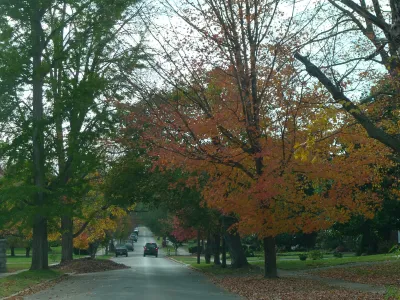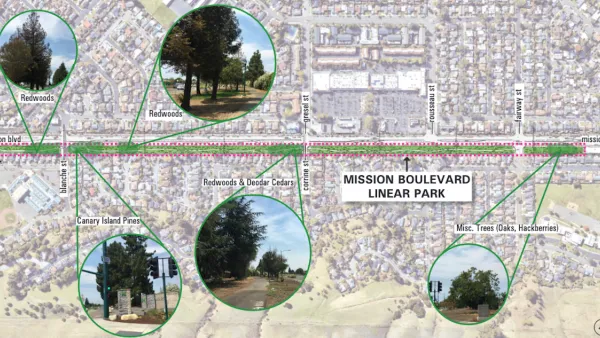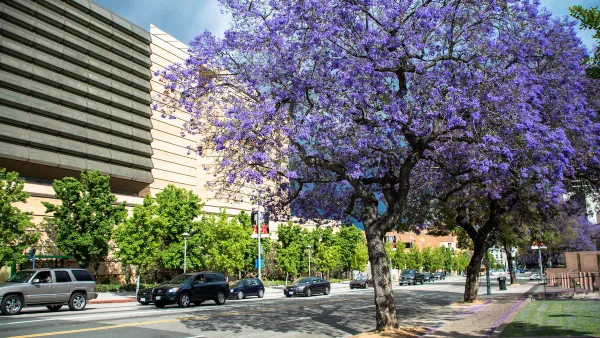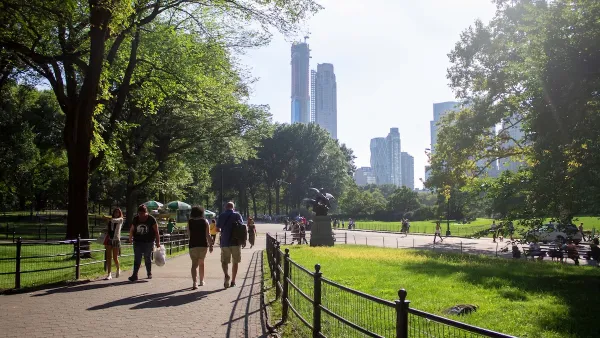A new study shows that regular exposure to trees and green spaces has a powerful impact on depression and mental health.

In a piece for The Guardian, Ashley Stimpson reports on new research that shows the importance of tree cover in urban neighborhoods and draws attention to the "tree inequity" that plagues many low-income communities.
"In many cities, a map of urban tree cover reflects the geography of race and income," Stimpson writes. Historic redlining, blamed for housing inequities and disinvestment, also has a significant impact on a neighborhood's trees—or lack thereof. "According to the US Forest Service, previously redlined areas have an average of 23% tree cover, while once-greenlined neighborhoods, living up to their old label, have an average of 43% tree cover."
Trees aren't just about aesthetics: studies show that they mitigate the urban heat island effect and boost residents' physical and mental health. "Summer days in East Baltimore neighborhoods," which are predominantly Black, historically redlined, and lack extensive tree cover, "can be four to 16 degrees hotter than other parts of the city." In such neighborhoods, residents face the risk of heat-related illnesses, higher cooling costs, and poorer air quality.
Now, research is zeroing in on the mental health effects of city trees. Using "the correlation between prescription antidepressants and tree cover across a range of neighborhoods," a group of researchers in Germany "were able to demonstrate in more material terms than ever before the correlation between trees and mental wellness." Their findings show that having trees within 100 meters of one's home is associated with reduced antidepressant use, a relationship "especially pronounced in residents with low socioeconomic status." The study's authors suggests that "'unintentional' everyday contact" with nature and "easily accessible urban green space" can have a noticeable positive impact on public health.
FULL STORY: Green health: a tree-filled street can positively influence depression, study finds

National Parks Layoffs Will Cause Communities to Lose Billions
Thousands of essential park workers were laid off this week, just before the busy spring break season.

Retro-silient?: America’s First “Eco-burb,” The Woodlands Turns 50
A master-planned community north of Houston offers lessons on green infrastructure and resilient design, but falls short of its founder’s lofty affordability and walkability goals.

Delivering for America Plan Will Downgrade Mail Service in at Least 49.5 Percent of Zip Codes
Republican and Democrat lawmakers criticize the plan for its disproportionate negative impact on rural communities.

Test News Post 1
This is a summary

Test News Headline 46
Test for the image on the front page.

Balancing Bombs and Butterflies: How the National Guard Protects a Rare Species
The National Guard at Fort Indiantown Gap uses GIS technology and land management strategies to balance military training with conservation efforts, ensuring the survival of the rare eastern regal fritillary butterfly.
Urban Design for Planners 1: Software Tools
This six-course series explores essential urban design concepts using open source software and equips planners with the tools they need to participate fully in the urban design process.
Planning for Universal Design
Learn the tools for implementing Universal Design in planning regulations.
EMC Planning Group, Inc.
Planetizen
Planetizen
Mpact (formerly Rail~Volution)
Great Falls Development Authority, Inc.
HUDs Office of Policy Development and Research
NYU Wagner Graduate School of Public Service





























